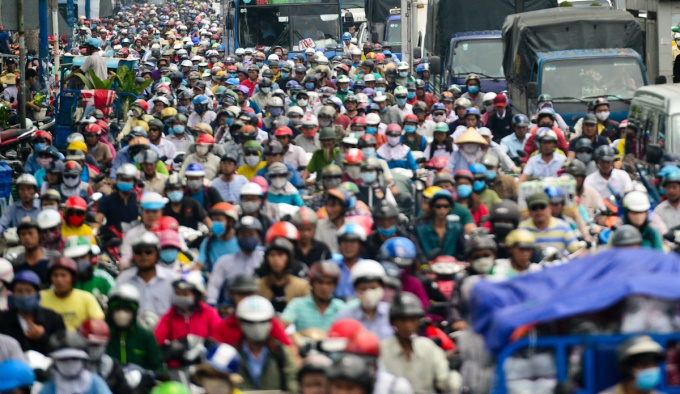What makes urban life so stressful in Vietnam and elsewhere?
By Vi Vu October 28, 2017 | 04:10 pm GMT+7

Both Hanoi and Saigon fare badly in many factors, especially in public transport, traffic, air pollution and debt per income.
Hanoi and Saigon, Vietnam’s largest cities, have been ranked 94 and 106 respectively out of 150 cities in a new study which looks into many economic, infrastructure and health factors to determine the well-being or urban communities around the world.
The ranking by Zipjet, a London-based online laundry service, seeks to provide insight on how the most stressful cities around the world can benefit from the example of those less affected by stress.
“Mental health problems are on the rise worldwide, with stress being a trigger and contributing factor towards this increase," Florian Färber, Zipjet's managing director, said in an online statement. "We hope that by pinpointing how the least stressful cities are managing this issue, those cities struggling with a stressed out population can overcome it.”
Factors measured include unemployment, debt per capita, traffic, public transport, security, pollution, physical and mental health, social security, as well as gender and race equality. The study also measures sunshine hours, fewer of which have been associated to higher risk of mental health.
Both Hanoi and Saigon fare badly in many factors, especially in public transport, traffic, air pollution and debt per income. However, its noise pollution, unemployment and gender equality problems are of less concern, according to the study.
Saigon’s density is ranked much higher than that of Hanoi, although both are still among the less crowded in the world. Saigon is now home to 13 million people including migrants while Hanoi’s population has reached seven million, according to official figures.
Public transport are poorly developed in both cities, which have seen a rapid rise in individual vehicles only at the expense of traffic safety and air quality. Many recent studies have shown pollution level in Hanoi and Saigon as beyond the World Health Organization standards most of the time.
Saigon’s density is ranked much higher than that of Hanoi, although both are still among the less crowded in the world. Saigon is now home to 13 million people including migrants while Hanoi’s population has reached seven million, according to official figures.
Public transport are poorly developed in both cities, which have seen a rapid rise in individual vehicles only at the expense of traffic safety and air quality. Many recent studies have shown pollution level in Hanoi and Saigon as beyond the World Health Organization standards most of the time.
Other cities in Southeast Asia are not doing well either.
Hanoi is actually the best performer in the region after Singapore (42). Phnom Penh ranks 96, Bangkok 104, Kuala Lumpur 110, Jakarta 132 and Manila 141.
The least stressful cities in Asia, according to the ranking, are Abu Dhabi (19), Kuwait (23) and Dubai (32).
The ranking shows a stark division between first and third world centers.
Although many large cities such as New York (84), Barcelona (85) and Seoul (129) fall into the second half of the list, the ranking shows that there is much less stress in developed cities and more in those cursed with daily hunger and violence.
European cities dominate the list, with Sydney the only outsider breaking into the top 10. Seattle (12) is the only American city in top 20.
The ranking’s bottom three are the conflicts-torn Lagos, Kabul and Baghdad, where people struggle with regular attacks and race conflicts.